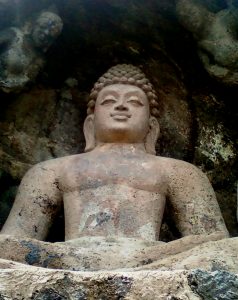Tags

Mindfulness of Breathing
Meditation on the Breath, or The Mindfulness of Breathing is a main stay of Buddhist meditation. It can be used in so many ways. Your mind calms, your body relaxes and you come to know peace in a way that is not usual in the West.
Breath meditation can be used anywhere, while sitting watching the T.V., whilst walking to the shops, even whilst standing in the queue in the shop. Whenever you have a chance to pause and take time out, breath meditation can come to your aid, and calm you down. It really isn’t complicated at all, as the following instructions will show. Just 15 minutes or half an hour a day, when you can grab it, can make an enormous impact on you day-to-day wellbeing.

Meditation
Another thing with Breath Meditation, is you do not have to be a practicing Buddhist to benefit from it. It just happens to be a widely known Buddhist practice. You can be Christian, Jew, Muslim, Atheist, Hindu or agnostic. Breath Meditation will benefit your life by creating a sense of calm and peace that will aid you through life’s twists and turns. It will be a tool for you to use in those difficult times, and it is also a brilliant aid to restful sleep. If all you do is practice it just before you go to sleep, you will sleep deeper and better than you know.
So, to the practicalities of the method. They are few and simple. The Buddhist practice is generally to sit on the floor, with legs crossed and a straight back, but this is not essential to benefit from the practice. Personally I practice in whatever position I find myself in as the urge takes me. I could be lying on the floor in front of the T.V., I could be slouching on the sofa or I could be in bed ready for the Sandman to come. Like I said above, I could also be in the queue at Tesco’s waiting for the checkout, it really does not matter.
- The first point to note is that you must be comfortable in yourself, whether standing, walking, sitting or lying down, you must be able to relax in that posture. Take a few deep breathes and ‘centre’ yourself i.e. prepare for the practice; in other words note the intent to practice. It’s like making a mental note: ‘I am now going to practice Breath Meditation’. Even in the checkout queue, you must be at ease and be reasonably able to shut out the noise of the surroundings. This can take a bit of practice but I am sure that after you have tried it once or twice, you will get the hang of it.
- Having relaxed a little then centre your concentration on your breathing, just as it is naturally. Do not TRY to breath, there is no need for long breaths or short breaths. There is no need to count or force your breathing in any way. Just take note of your breathing how it is at this moment. If you feel the need to take a deep breath for some reason then do so, if you feel the need to change the pace of your breathing then do so. The fact that you are focusing on your breathing, no matter how you are breathing, is what matters.
- You can focus on several areas whilst practising this meditation. When focusing on the breath you can focus on the tip of your nose and the feeling of the breath entering and exiting your nose; you can focus on the rise and fall of your chest or you can focus on the rise and fall of your stomach. The choice is yours and whatever makes the meditation easier for you is the way to go.
- ADDENDUM: You will find that your mind will probably fill with all sorts of thoughts and concerns when you first begin this practice. Do not be concerned. Everybody goes through this. When you realise a thought has arisen, let it take its path then fade away, just as a leaf passes you by on a stream. Once the thought has gone, gently bring your concentration back to your breath and continue as before. Do not try to force your mind to be blank, this is not the idea. Beginners are often concerned that the ‘monkey mind’ will just not shut up, but only continual practice will achieve this. Never be concerned about the number of times your breath meditation is interrupted in this way. After all, it is a ‘practice’, and as the old adage goes, ‘practice makes perfect’.
- Even just 5 minutes of this practice will reap rewards. 30 minutes to an hour a day will be far better, but it is much more beneficial to start small and build up gradually than it is to aim high and fail. Build your confidence and comfort with the practice gradually, and soon enough you will be a past master at Buddhist Breath Meditation.

A Rock cut Seated Buddha Statue at Bojjannakonda, Visakhapatnam District
I hope the above will be of benefit to those looking at starting their own meditation practice. It is a simple practice, but reaps far greater rewards than may be immediately clear. This practice has been a mainstay of Buddhist meditation for 2400 years so there must be something to it! As I have stated above, do not be concerned by the number of interruptions you experience. Even the most practiced and experienced meditator should admit that they suffer from the same problem, maybe not as much as you, but they do. So take a deep breath, centre yourself and focus on that breath. Let any thoughts drift by like feathers on the wind and keep bringing the mind back to your breath. You will reap many benefits.
For those wishing a more extensive discussion on the Mindfulness of the Breath I have provided a copy of The Satipatthana Sutta: The Discourse on Mindfulness Meditation which gives extensive examples of various other practices that can be tried during the Breath Meditation.
May all Sentient Beings live without fear.
